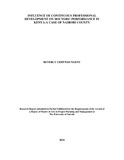| dc.description.abstract | Continuous Professional Development within the medical fraternity is the critical on-job
training phenomenon inculcated in professional career progression so as to enhance
efficiency, effectiveness and competence in healthcare service delivery. Many studies have shown that the acquisition of new knowledge and skills does not necessarily mean a change in performance and new knowledge is not always directly applied to practice. The purpose of this study therefore was to establish the influence of Continuous Professional Development on doctors’ performance. The key objectives of this study were to determine the influence of formal learning program, mentorship program and implementation of Continuous
Professional Development Cycle as the independent variables on doctors’ performance as the dependent variable. The phenomenon that studied the influence of formal learning, mentorship program and implementation of CPD Cycle on doctors’ performance was tested
through null hypothesis H01, H02and H03. This study was guided by Knowles’ Adult Learning
Theory proposed by Malcom Knowles in 1950 which discusses on the principles of adult
learning. The research design of this study was descriptive survey research design. The target
population of this study was200 doctors practising in Nairobi County. The sampling
procedure used was the stratified random sampling which was used to sample the respondents
from Nairobi County stratifying them into public medical and dental officers, private
practitioners and specialists. The sample size of this study was determined following Patton (1990) method of sample calculation. A self-administered structured questionnaire was used to collect data via informed consent from a sample of 65 doctors: 30 public dental and medical officers, 20 private practitioners and 15 specialists. The quantitative data in this research was analyzed by descriptive statistics using statistical package for social sciences
SPPS (V.17.0). Quantitative data was analysed using descriptive statistics including
frequency distribution, percentages, measures of central tendency and standard deviations.
The specific effect of independent variables vis-à-vis the dependent variable was tested
through multivariate analysis. The test of hypotheses to determine the level of significance of
an independent variable against the dependent variable was tested through regression
analysis. Content validity was used to ensure validity of the research instruments. Split half method was used to ensure that the research instrument is reliable. The reliability coefficient derived was 0.857 which was more than 0.7, therefore the instrument was deemed reliable.
The research instruments were piloted. The study found and concluded that CPD formal
learning programs had the highest influence on doctors’ performance followed by mentorship program while implementation of Continuous Professional Development cycle had the lowest
influence on doctors’ performance. Through multiple regression analysis, at 95% confidence interval (0.05 level of significance), formal learning (with t statistic p value <0.001 < 0.05)
was highly significant, mentorship program (with t statistic p value <0.004 < 0.05) was
significant while implementation of CPD cycle (with t statistic p value p = 0.485 > 0.05) had no significant influence on doctors’ performance. This study therefore rejected null
hypotheses H01 and H02 and accepted null hypothesis H03 hence alternate hypotheses H1 and H2
were accepted while alternate hypothesis H3 was rejected | en_US |

